
Gallia Lugdunensis was a province of the Roman Empire in what is now the modern country of France, part of the Celtic territory of Gaul formerly known as Celtica. It is named after its capital Lugdunum, possibly Roman Europe's major city west of Italy, and a major imperial mint. Outside Lugdunum was the Sanctuary of the Three Gauls, where representatives met to celebrate the cult of Rome and Augustus.
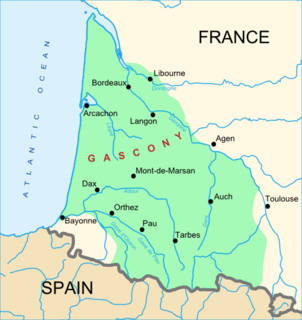
Gascony is a province of southwestern France that was part of the "Province of Guyenne and Gascony" prior to the French Revolution. The region is vaguely defined, and the distinction between Guyenne and Gascony is unclear; by some they are seen to overlap, while others consider Gascony a part of Guyenne. Most definitions put Gascony east and south of Bordeaux.
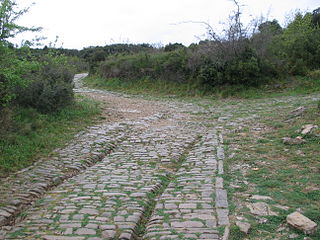
The Via Domitia was the first Roman road built in Gaul, to link Italy and Hispania through Gallia Narbonensis, across what is now southern France. The route that the Romans regularised and paved was ancient when they set out to survey it, so old that it traces the mythic route travelled by Heracles.

Armorica or Aremorica is the name given in ancient times to the part of Gaul between the Seine and the Loire that includes the Brittany Peninsula, extending inland to an indeterminate point and down the Atlantic Coast.

Gallia Aquitania, also known as Aquitaine or Aquitaine Gaul, was a province of the Roman Empire. It lies in present-day southwest France, where it gives its name to the modern region of Aquitaine. It was bordered by the provinces of Gallia Lugdunensis, Gallia Narbonensis, and Hispania Tarraconensis.
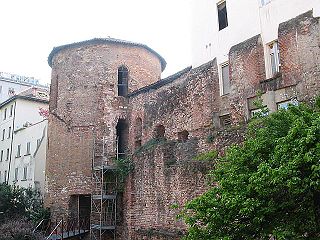
Mediolanum, the ancient city where Milan now stands, was originally an Insubrian city, but afterwards became an important Roman city in northern Italy. The city was settled by the Insubres around 600 BC, conquered by the Romans in 222 BC, and developed into a key centre of Western Christianity and informal capital of the Western Roman Empire. It declined under the ravages of the Gothic War, its capture by the Lombards in 569, and their decision to make Ticinum the capital of their Kingdom of Italy.

Gallia Narbonensis was a Roman province located in what is now Languedoc and Provence, in southern France. It was also known as Provincia Nostra, from its having been the first Roman province north of the Alps, and as Gallia Transalpina, distinguishing it from Cisalpine Gaul in northern Italy. It became a Roman province in the late 2nd century BC. Its boundaries were roughly defined by the Mediterranean Sea to the south and the Cévennes and Alps to the west and north. The western region of Gallia Narbonensis was known as Septimania.

The Lingones were a Gallic tribe of the Iron Age and Roman periods. They dwelled in the region surrounding the present-day city of Langres, between the provinces of Gallia Lugdunensis and Gallia Belgica.

The Remi were a Belgic tribe dwelling in the Aisne, Vesle and Suippe river valleys during the Iron Age and the Roman period. Their territory roughly corresponded the modern Marne and Ardennes and parts of the Aisne and Meuse departments.

The Suessiones were a Belgic tribe, dwelling in the modern Aisne and Oise regions during the La Tène and Roman periods.
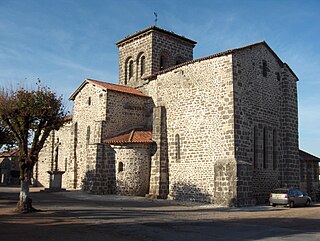
Chassenon is a commune in the Charente department in southwestern France.
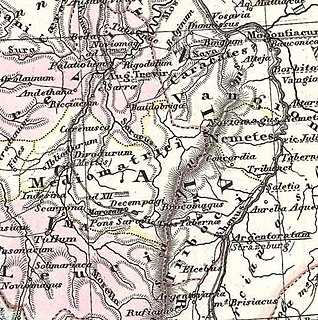
The Mediomatrici were a Belgic tribe dwelling in the present-day Lorraine region during the Iron Age and the Roman period.

The Triumphal Arch of Orange is a triumphal arch located in the town of Orange, southeast France. There is debate about when the arch was built, but current research that accepts the inscription as evidence favours a date during the reign of emperor Augustus. It was built on the former via Agrippa to honor the veterans of the Gallic Wars and Legio II Augusta. It was later reconstructed by emperor Tiberius to celebrate the victories of Germanicus over the German tribes in Rhineland. The arch contains an inscription dedicated to emperor Tiberius in AD 27. On the northern (outward-facing) facade, the architrave and cornice have been cut back and a bronze inscription inserted, now lost; attempts at reconstructing its text from the placement of cramp holes for the projecting tines of its letters have not been successful. The arch is decorated with various reliefs of military themes, including naval battles, spoils of war and Romans battling Germanics and Gauls. A Roman foot soldier carrying the shield of Legio II Augusta is seen on the north front battle relief.
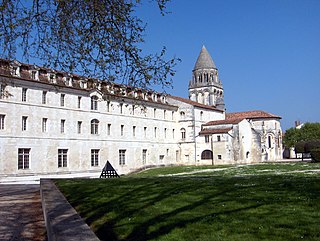
The Abbaye aux Dames was the first Benedictine nunnery in Saintes in Charente-Maritime in France. The abbey was founded in 1047 by Geoffrey II, Count of Anjou, and his wife Agnes. Agnes later retired to the nunnery and died there.

The Arch of Germanicus is an ancient Roman arch in Saintes, Charente-Maritime in France. It was built in 18 or 19 by a rich citizen of the town, C. Julius Rufus, and dedicated to the emperor Tiberius, his son Drusus Julius Caesar, and his adoptive son Germanicus. It has two bays and was originally sited over the terminus of the Roman road from Lyon to Saintes. On the proposal of Prosper Mérimée in 1843 it was moved fifteen metres during works on quays along the river, and it was restored in 1851.

The Amphitheatre of the Three Gauls of Lugdunum (Lyon) was part of the Sanctuary of the Three Gauls dedicated to the cult of Rome and Augustus celebrated by the 60 Gallic tribes when they gathered at Lugdunum. In 1961, it was classified as a monument historique.

The term "Gallo-Roman" describes the Romanized culture of Gaul under the rule of the Roman Empire. This was characterized by the Gaulish adoption or adaptation of Roman culture, language, morals and way of life in a uniquely Gaulish context. The well-studied meld of cultures in Gaul gives historians a model against which to compare and contrast parallel developments of Romanization in other, less-studied Roman provinces.

The Sotiates were a Gallic-Aquitani tribe dwelling in the region surrounding the modern town of Sos (Lot-et-Garonne) during the Iron Age and the Roman period.
The Catuslugi were a small Belgic coastal tribe dwelling around modern-day Incheville (Normandy) during the Roman period.
The Avantici were a small Gallic tribe dwelling around present-day Gap, in the western part of the modern Hautes-Alpes department, during the Roman period.






















